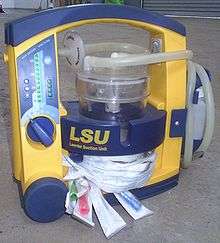Suction (medicine)

In medicine, devices are sometimes necessary to create suction. Suction may be used to clear the airway of blood, saliva, vomit, or other secretions so that a patient may breathe. Suctioning can prevent pulmonary aspiration, which can lead to lung infections. In pulmonary hygiene, suction is used to remove fluids from the airways,[1] to facilitate breathing and prevent growth of microorganisms.
In surgery suction can be used to remove blood from the area being operated on to allow surgeons to view and work on the area. Suction may also be used to remove blood that has built up within the skull after an intracranial hemorrhage.[2]
Suction devices may be mechanical hand pumps or battery or electrically operated mechanisms. The plastic, rigid Yankauer suction tip is one type of tip attached to a suction unit. Another is the plastic, nonrigid French or whistle tip catheter.[3] A suction unit is a device for removing liquids or gases by suction it from the patient. Professionals use it to remove mucus, serum or blood from a body cavity. Suction machine is used also for Home Care. Suctioning could remove fluids or mucus from airways. The potential of this machine could be in need also when you have a moist cough, and you’re unable to effectively clear secretions from the throat, or are having difficulty breathing.
References
- ↑ Allen GS, Coates NE (November 1996). "Pulmonary contusion: A collective review". The American Surgeon. 62 (11): 895–900. PMID 8895709.
- ↑ Valadka AB (2004). "Injury to the cranium". In Moore EJ, Feliciano DV, Mattox KL. Trauma. New York: McGraw-Hill, Medical Pub. Division. pp. 385–406. ISBN 0-07-137069-2. Retrieved 2008-08-15.
- ↑ Pollak, Andrew N. (ed.) (2011). "Chapter 9: Airway Management". Emergency Care and Transportation of the Sick and Injured. Jones and Bartlett Publishers. p. 343. ISBN 978-0-7637-7828-6
